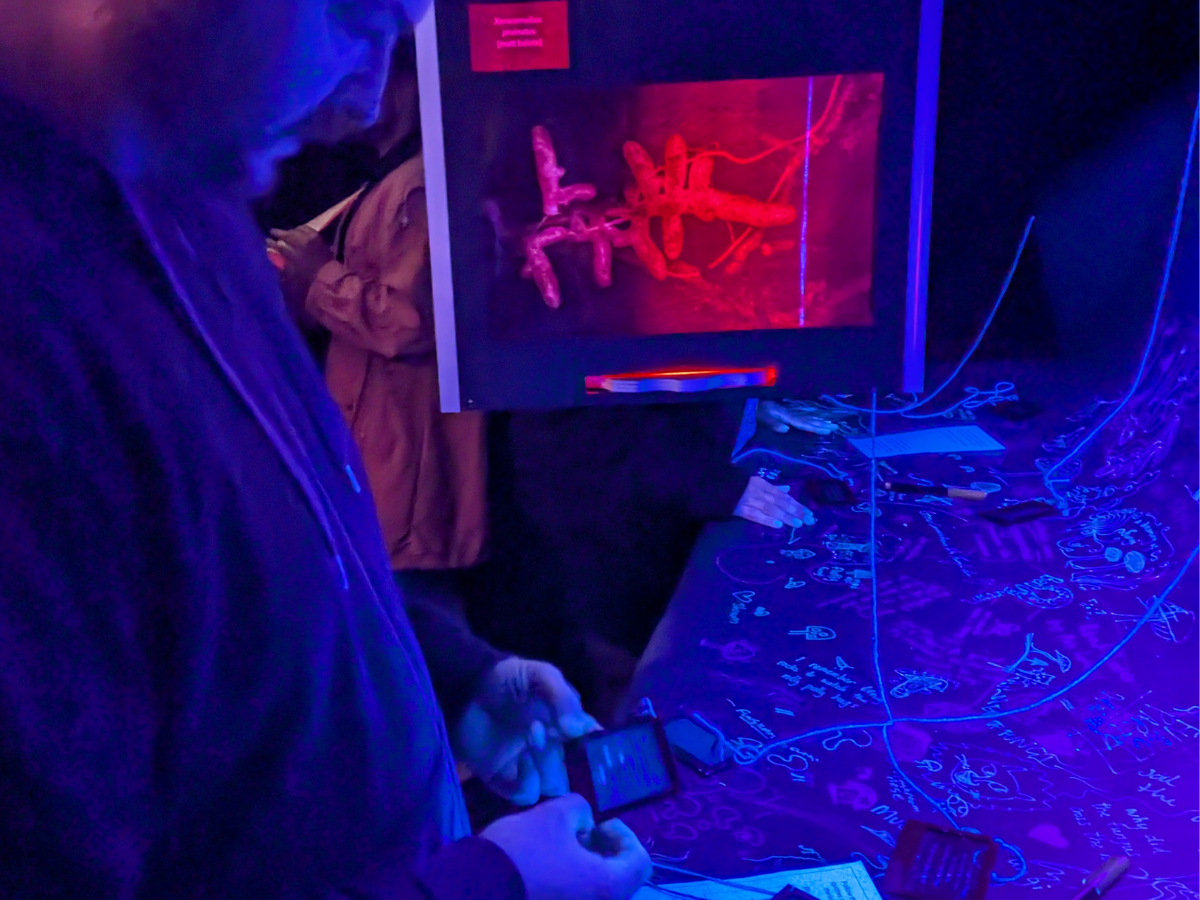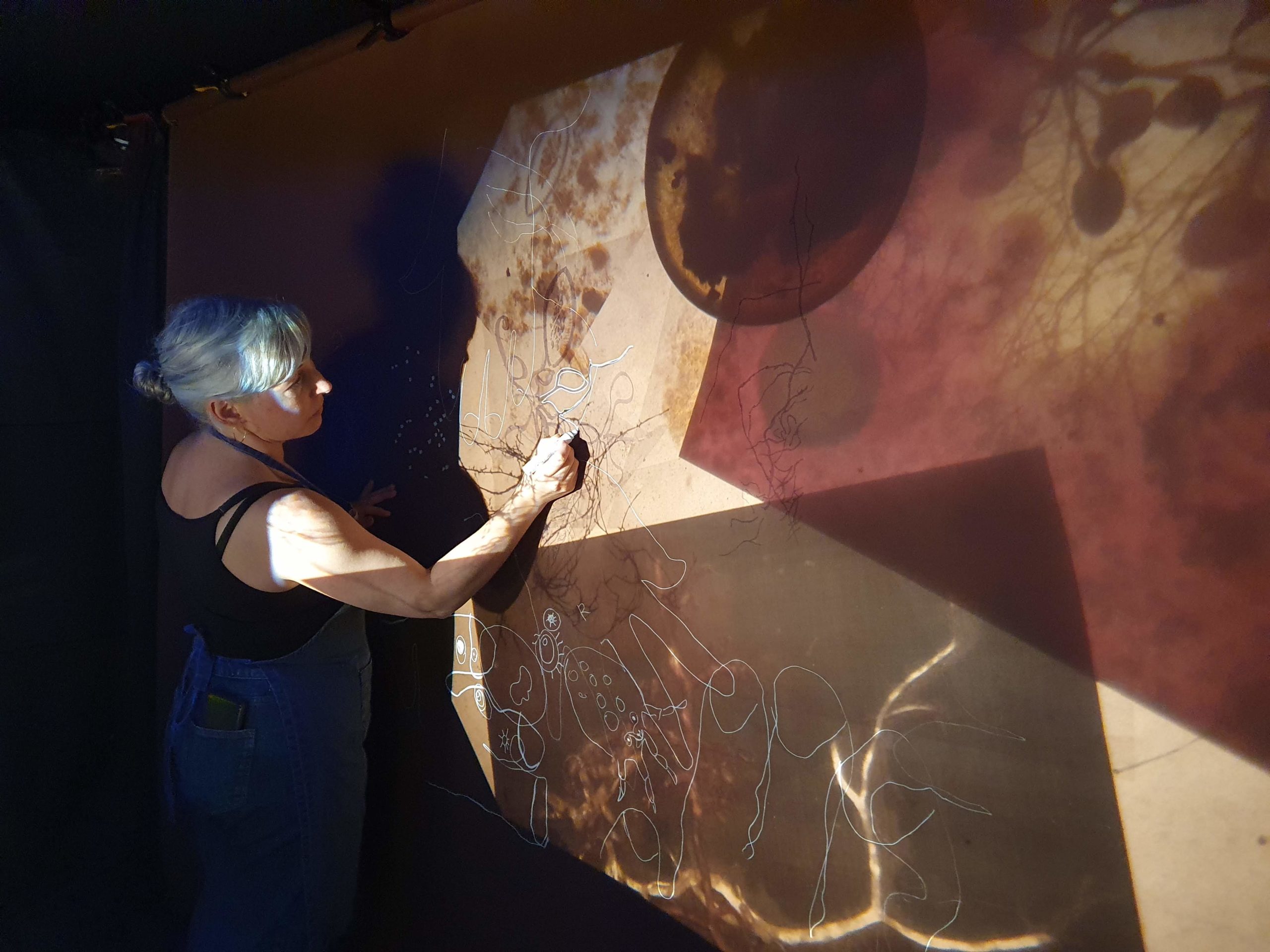(un)common threads
About This Project
The journey to creating (un)common threads started in late 2023 when
I attended a talkhosted by the South London Botanical Institute titled
Ancient Associations: Mycorrhizas in Changing Forests with Dr. Laura M. Suz
(Senior Research Leader in Mycology at Royal Botanic Gardens, Kew).
What struck me about Laura’s research was how it drew a clear thread between nitrogen pollution,
biodiversity loss and predicted consequences of reduced forest resilience
and soil carbon sequestration.
It was a bit of a lightbulb moment; I knew these things were ‘bad’;
but here was someone illustrating a link
between air pollution from industry and the climate crisis.
What really set my imagining whirring were the beautiful photographs
Laura had taken of the mycorrhizal specimens she and her team were studying.
The images of fungal hyphae and rhizomorphs around the root hairs
of their host tree were taken through a microscope with a black background
instead of the standard white giving them a transcendental quality.
A significant way marker for this (un)common threads was an exhibition during
London Fungi Festival Week in October 2025. It was created in partnership with
Fat Fox Mushrooms at the London National Park City Visitor Centre (Oxford Street)
and funded by the British Mycologcal Society Massee Arts Grant.
As well as communicating an alarming story of ecological tipping points,
we also celebrated fungal diversity; highlighting its ecological importance
and sharing examples where ecosystem restoration is working.
The interactive installation was built in close collaboration with Benji Bailes (Bailes+Light) and
is accompanied by an original spatial soundscape by artist Lez Kosanke.
Where the (un)common threads take us next is yet to emerge
but the mycorrhizal fungi shown in the responsive, rotating lightboxes are ready for
another turn in the spotlight.
Research as muse – the interpretation explaining the installation
‘Mycorrhizas are symbiotic partnerships between plants and fungi that have been shaping the Earth’s carbon cycle for 500 million years’.
However, the ecological conditions in which that symbiosis exists have been subjected to significant changes due to human activity in a mere 150 – 200 years.
(un)common threads is inspired by research by Dr Laura Suz and her team into how these ancient, carbon sequestering ectomycorrhizal fungi are being impacted, and knock on consequences.
They studied forests that are part of the ICP Forest network – the International Co-operative Programme on Assessment and Monitoring of Air Pollution Effects on Forests. Data has been gathered from over 6000 ICP forest plots since the programme was established in 1985 making it a vital resource for identifying trends and changes over time and location.
Researchers took 13,000 soil cores from 137 ICP forest plots of oak, beach, spruce and pine trees in 20 countries – nearly 40,00 mycorrhizas were identified by DNA fingerprinting. The images in the installation were taken by Dr Suz during the process of visually examining the ectomycorrhizas collected in 22 oak sites across 9 countries and they show how these fungi explore the soil through their rhizomorphs and hyphae.
The research revealed that there are five key changing factors in the forests that are affecting ectomycorrhizas including mean annual air temperature or forest floor pH. Nitrogen ‘throughfall- deposition’ came out on top as the most critical factor negatively impacting the fungal communities in the roots of trees.
Deposition is the movement of substances in the atmosphere onto the soil, in this case, through the forest canopy. Atmospheric nitrogen has increased due to industrial activity such as farming, power generation and aviation and the deposition occurs relatively close to the source – the highest recordings in Europe are in Germany, Belgium and the Netherlands, England is in the middle range and Scandinavia is mostly still at pre-industrial levels.
Some fungi are tolerant to the increased nitrogen, known as nitrophilic. They thrive in the polluted soil therefore replacing the fungal species that are sensitive to nitrogen, or nitrophobic. Typically nitrophobic fungi have medium to long-distance hyphae and specialised rhizomorphs; by growing more biomass in the soil, they are drawing more carbon down from their tree associates.
‘Worryingly, some of the fungi most sensitive to high nitrogen are those that pump more carbon into the soil.’
The research is pointing to a tipping point for forests influenced by increased nitrogen deposition. It leads to changes in tree ectomycorrhizal communities which influences tree mineral nutrition. If mycorrhizal communities in the roots of trees change too much and are not able to provide trees with the nutrients they need, once forests cross this tipping point, it might not be possible to reverse by only reducing nitrogen levels. A new ‘normal’ within the ecosystem could have been established and the consequences of this are as yet unknown.
However, researchers in Laura’s team have re-sampled a subset of those forest sites for ectomycorrhizas after more than 10 years of the initial sampling. They will now be able to assess if after a decrease in nitrogen deposition, mycorrhizal communities have been able to recover.
The belowground world is so enticing from a creative and scientific perspective because there are so many questions yet to be defined, let alone answered.
‘It is important that we continue to investigate the soil ‘black box’ and establish the consequences of human activities on the organisms that drive many vital ecosystem processes, and whether and how these effects can be predicted, mitigated or reversed.’
Definitions
Ecto-myco-rhizal = from the greek meaning outer-fungi-root (the fungal filaments surround the fine root tips without penetrating the root cells).
Hyphae – the main form of fungal growth that forms the mycelial network, single threads of fungal tubular cells.
Rhizomorphs – structures in ectomycorrhizas form by multiple hyphae for the long-distance transport of water and nutrients. Some of them are waterproof to avoid any leakage.
Biomass – the quantity or weight of organisms in a given area or volume.
Tipping point – abrupt shift in ecosystem condition that might be difficult to reverse.
References:
Data and quotes are all from ‘Suz,Laura M. and Bode,Jessica and Byrne,Alexander and van der Linde,Sietse and Bidartondo,Martin I. Quarterly Journal of Forestry, January 2022 Vol 116 (36–43), The Royal Forestry Society, Nutrients, carbon, mycorrhizas and tipping points in forests. (2022)















